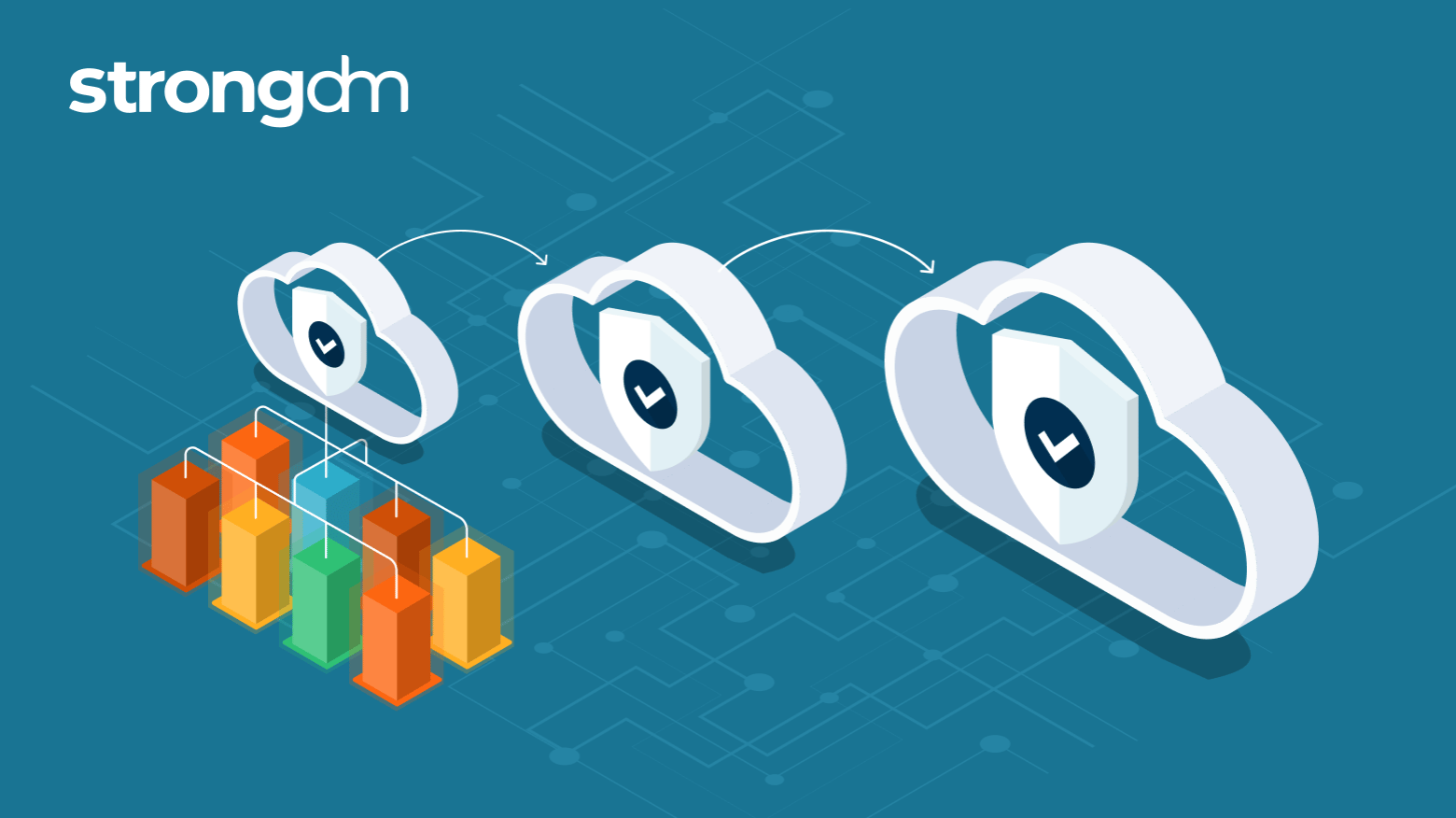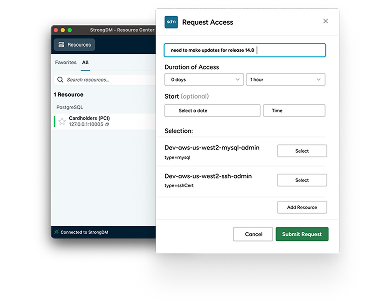

Written by
StrongDM TeamLast updated on:
October 7, 2025Reading time:
Contents
Built for Security. Loved by Devs.
- Free Trial — No Credit Card Needed
- Full Access to All Features
- Trusted by the Fortune 100, early startups, and everyone in between
The terms “multi-cloud” and “hybrid cloud” are often used interchangeably, but they solve very different problems. Multi-cloud uses multiple public cloud providers. A hybrid cloud blends public cloud with private or on-prem infrastructure. Your goals, compliance needs, and existing architecture determine which is right for you.
This guide breaks down the key differences in architecture, use cases, benefits, and challenges. You’ll also get security considerations for both models, plus a future-looking take on distributed cloud.
What Is the Difference Between Multi-Cloud and Hybrid Cloud?
The difference between multi-cloud and hybrid cloud lies in how cloud resources are combined and used. Multi-cloud refers to using multiple public cloud providers at once (such as AWS, Azure, and Google Cloud) to improve flexibility, avoid vendor lock-in, and increase resilience. Hybrid cloud blends public cloud with private cloud or on-premises infrastructure, allowing organizations to keep sensitive workloads on private systems while leveraging the scalability of public cloud for other tasks.
Multi-Cloud vs Hybrid Cloud: Key Differences
- Infrastructure composition: Multi-cloud refers to using multiple public cloud providers, whereas hybrid cloud is a combination of public cloud and private/on-premises infrastructure.
- Primary goal: Organizations typically use a multi-cloud approach for resilience and flexibility, and a hybrid cloud approach for control and compliance.
- Workload placement: In multi-cloud environments, organizations distribute workloads across multiple providers. In hybrid environments, organizations distribute workloads on-premises or in private cloud, using public cloud as needed.
- Complexity: Multi-cloud involves managing multiple vendors; hybrid cloud involves integrating on-premises and cloud systems.
Here's a comparison table so you can clearly see the difference between hybrid and multi-cloud:
| Multi-Cloud | Hybrid Cloud | |
| Architecture | Multiple public clouds | Mix of private cloud and on-premises/public cloud |
| Use cases | Avoiding vendor lock-in, customization, etc. | Keeping sensitive data secure, modernizing legacy systems, etc. |
| Benefits | Resilience, flexibility | Control, compliance |
| Challenges | Managing multiple cloud providers simultaneously | Integrating on-prem and cloud infrastructure, which can be difficult |
What Are Multi-Cloud and Hybrid Cloud?
Many people confuse these cloud strategies, so here's what multi-cloud and hybrid cloud actually mean:
What Is Multi-Cloud?
Multi-cloud is a cloud strategy that uses two or more public cloud providers simultaneously. Some of the most popular cloud providers include Amazon Web Services (AWS), Microsoft Azure, and Google Cloud. Eighty-nine percent of organizations have embraced multi-cloud environments.
Key Features of Multi-Cloud
- Avoid vendor lock-in
- Leverage best-of-breed services from each provider
- Optimize for pricing and redundancy
Multi-Cloud Use Case
A fintech company may use AWS for compute and storage while leveraging Google Cloud for AI and machine learning.
What Is Hybrid Cloud?
Hybrid cloud is a cloud strategy that combines public cloud(s), private cloud(s), and/or on-premises infrastructure, allowing you to move data and workloads between them.
Key Features of Hybrid Cloud
- Deployment of sensitive workloads on-premises
- Elastic scaling via public cloud
- Legacy system integration with cloud-native applications
Hybrid Cloud Use Case
A healthcare provider may maintain patient records on-premises to increase compliance with HIPAA and use Microsoft Azure for other tasks, such as data analytics.
Benefits of Multi-Cloud and Hybrid Cloud
Here are some of the benefits of each cloud strategy so you can choose the one that best fits your needs:
Benefits of Multi-Cloud
- Reduced vendor lock-in: Spreading workloads across multiple cloud providers means you're not dependent on a single company, giving you more flexibility and control.
- Optimized performance: Choosing the top-performing services and solutions from each cloud provider (known as 'best-of-breed') means you're utilizing each for what it excels at handling.
- Increased resilience and uptime: Extending workloads across multiple providers ensures your systems remain operational even if one provider experiences downtime.
- Negotiated pricing: With no vendor lock-in, you can shop around for different providers, negotiate costs, and potentially save money.
Benefits of Hybrid Cloud
- Security and compliance alignment: You can keep sensitive data and workloads on-premises to enhance security and compliance with frameworks such as GDPR and HIPAA.
- Cost control for legacy workloads: You can run older systems on existing on-premises infrastructure and private cloud, and use public cloud as needed, which can reduce costs.
- Improved scalability: The public cloud can handle spikes in demand without requiring you to invest in extra on-premises hardware, thereby increasing scalability while potentially saving you money. You can also maintain control over critical data.
- Legacy system modernization: With hybrid cloud, you can integrate legacy systems with current cloud-native applications without the complexities of a full migration.
Challenges of Multi-Cloud and Hybrid Cloud
Each cloud strategy presents certain obstacles that your organization needs to know about:
Challenges of Multi-Cloud
- Managing multiple providers: With multi-cloud, you'll be dealing with at least two separate cloud providers, which can increase complexity and operational challenges and be time-consuming, especially for small teams.
- Inconsistent security: Each provider will have its own security policies, which may increase rifts in your setup that cybercriminals can exploit.
- Skills gaps: DevOps and site reliability engineering (SRE) teams may lack the experience or expertise to manage multiple clouds simultaneously.
- Increased costs: Without proper planning, you may incur higher operational costs when running a multi-cloud environment. For example, data transfer fees from multiple providers could impact your bottom line.
Challenges of Hybrid Cloud
- Data integration and latency: Transferring data between on-prem and cloud might cause delays, increased latency, and potential downtime that affects business operations.
- Security and compliance consistency: Ensuring you have the same security and compliance policies across on-prem and cloud can be a challenge.
- Legacy system bottlenecks: Older systems may be difficult to integrate with cloud infrastructure, which can impact scalability.
- Infrastructure and maintenance costs: You'll need to pay for hardware, licenses, security, and other costs when setting up and maintaining a hybrid cloud environment, which can be expensive.
Security Considerations in Multi-Cloud and Hybrid Cloud
Here are some security considerations to keep in mind when deciding between multi-cloud vs hybrid cloud:
- Identity and Access Management: Different providers have different rules for Identity and Access Management (IAM), which can lead to policy fragmentation and increased risk.
- Visibility and monitoring gaps: When workloads are spread across multiple or mixed cloud environments, it can be challenging to view everything together. This may result in security blind spots and make it more difficult to respond to issues.
- Compliance complexity: Complying with GDPR, PCI-DSS, SOC 2, and other frameworks can be challenging when data is stored in different locations. Failing to adhere to regulations may negatively impact your reputation and result in government penalties.
- Data protection: You need consistent encryption, key management, and data residency policies to protect your data. However, maintaining consistency isn't always easy when you have multiple or mixed cloud environments.
- Threat surface expansion: The addition of more clouds and providers introduces potentially more entry points and an increased attack surface, putting your business at risk.
- Zero Trust necessity: To increase security, treat every user and system as 'untrusted' by default (known as Zero Trust). Requiring verification before granting access to your resources can enhance the security of your cloud setup.
Multi-Cloud vs Hybrid Cloud: Which One Should You Choose?
Deciding between multi-cloud and hybrid cloud all depends on your goals, budget, existing infrastructure, and other factors. However, here are some points to consider:
Multi-Cloud is Best For
- Organizations wanting to avoid vendor lock-in
- Businesses that need redundancy and agility from their cloud setup
- Teams that want the flexibility of choosing best-in-breed services from different cloud providers
Hybrid Cloud is Best For
- Highly regulated industries, such as finance, government, and healthcare
- Enterprises that want to modernize legacy systems gradually
- Organizations with strict data residency requirements
The Future of Cloud Strategies
Gartner predicts that by 2028, one in four organizations will be significantly dissatisfied with their cloud adoption because of uncontrolled costs, unrealistic expectations, and other factors. As a result, many may seek out alternative cloud strategies, such as multi-cloud and hybrid environments. In Q3, 2024, 88% of cloud buyers ran or planned to run a hybrid cloud environment, while 79% leveraged multiple cloud providers.
Distributed cloud, which combines aspects of both multi-cloud and hybrid cloud, is another growing trend. This strategy enables organizations to leverage multiple cloud providers and on-premises infrastructure, distributing workloads across various locations. As a result, they can improve scalability, redundancy, and performance. Unlike multi-cloud and hybrid cloud, distributed cloud allows for centralized management and governance, making it easier to enforce security policies and identify threats.
Whatever strategy you choose, consider implementing Zero Trust principles. By assuming that no user is inherently trustworthy and implementing strict access controls, you can reduce the risk of data breaches and other security incidents.
Why StrongDM is the Secure Foundation for Multi-Cloud and Hybrid Cloud Environments
As organizations scale across multiple clouds and hybrid infrastructures, the biggest challenge isn’t just where workloads run, it’s how securely they’re accessed. Each cloud provider and on-prem system brings its own authentication model, policy language, and audit format. This patchwork often leads to inconsistent controls, orphaned credentials, and blind spots that attackers exploit.
StrongDM unifies access across every environment, public, private, or hybrid into one Zero Trust control plane. It replaces VPNs, static credentials, and manual provisioning with real-time, policy-driven access that scales with your infrastructure. Whether your databases live in AWS and Azure or your Kubernetes clusters run on-prem, StrongDM provides consistent security, visibility, and governance across it all.
How it works:
- Unified Identity & Access Control: Integrates with identity providers like Okta, Azure AD, and Google to enforce SSO and federated authentication across clouds.
- Cedar-based Policy Engine: Applies fine-grained, context-aware rules that evaluate user, device, and resource context in real time ideal for multi-cloud complexity.
- Just-in-Time Access: Eliminates standing privileges by granting time-bound access that expires automatically after use.
- Credential Injection: Removes the need for shared credentials entirely, brokering secure connections to databases, servers, and clusters without users ever seeing or handling secrets.
- Full Audit Visibility: Every query, SSH session, and connection is recorded in an immutable log, simplifying compliance across environments like SOC 2, HIPAA, and ISO 27001.
With StrongDM Gateways and Relays, encrypted traffic flows directly between your users and resources across AWS, GCP, Azure, and on-prem systems via TLS 1.3 tunnels that maintain end-to-end security without agents or re-architecting networks.
In short: StrongDM turns fragmented cloud access into a single, secure fabric. It enforces Zero Trust, automates least privilege, and gives teams the agility to operate confidently across hybrid and multi-cloud environments without ever compromising security or speed.
Want to simplify access across your cloud strategy? Book a StrongDM demo to see how we secure any infrastructure, anywhere.
Next Steps
StrongDM unifies access management across databases, servers, clusters, and more—for IT, security, and DevOps teams.
- Learn how StrongDM works
- Book a personalized demo
- Start your free StrongDM trial

Categories:

About the Author
StrongDM Team, Universal Privileged Access Authorization (UPAA), the StrongDM team is building and delivering a Zero Trust Privileged Access Management (PAM), which delivers unparalleled precision in dynamic privileged action control for any type of infrastructure. The frustration-free access stops unsanctioned actions while ensuring continuous compliance.
You May Also Like




